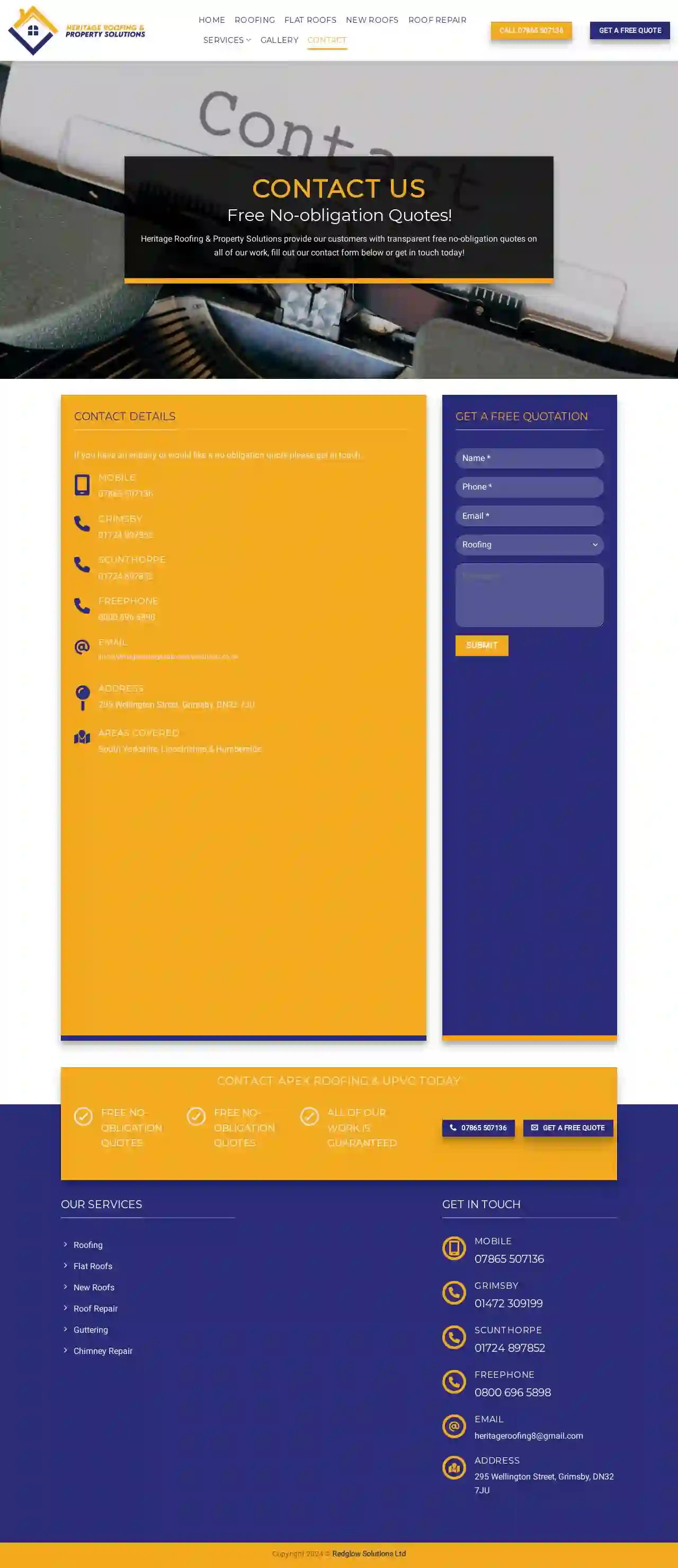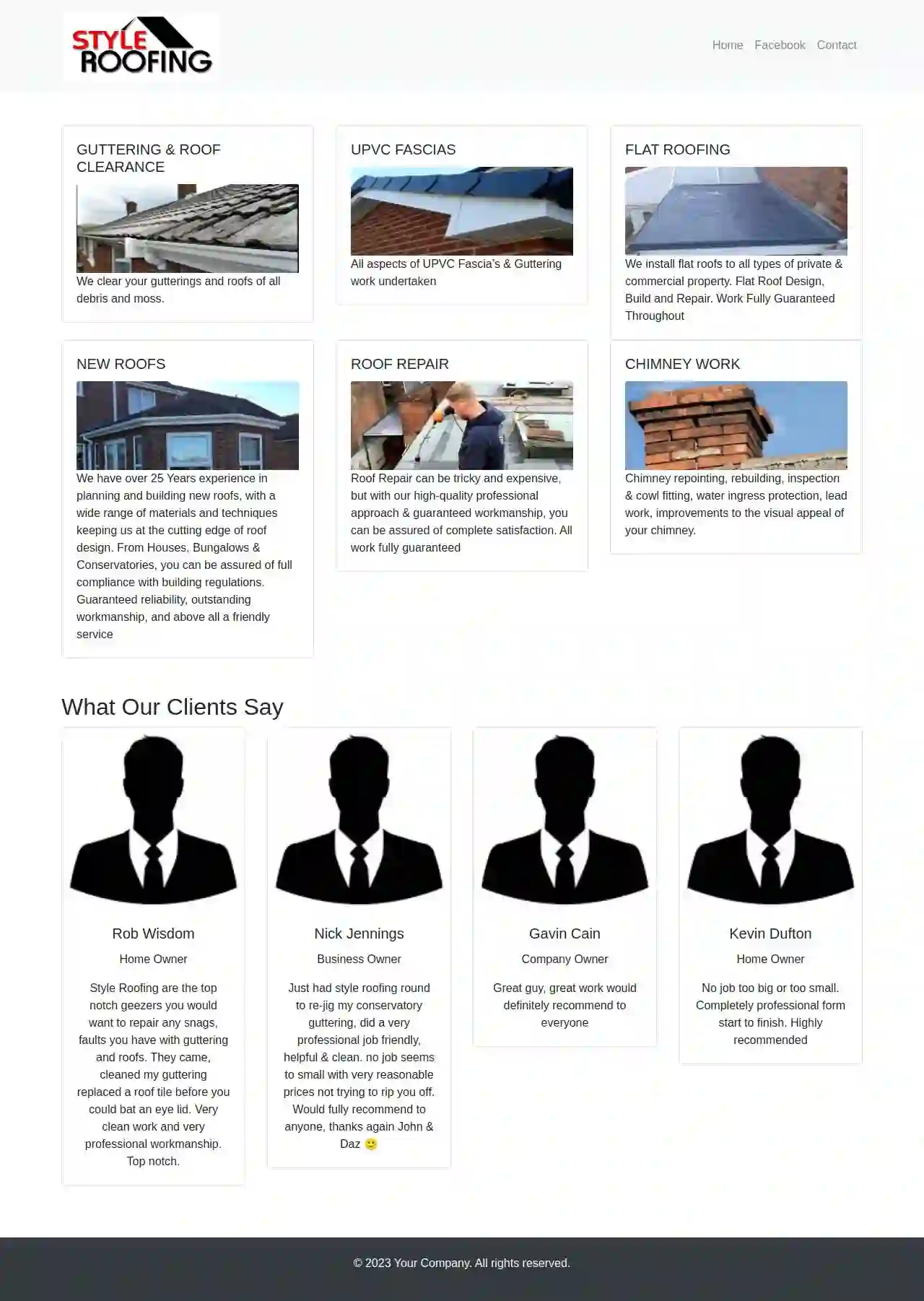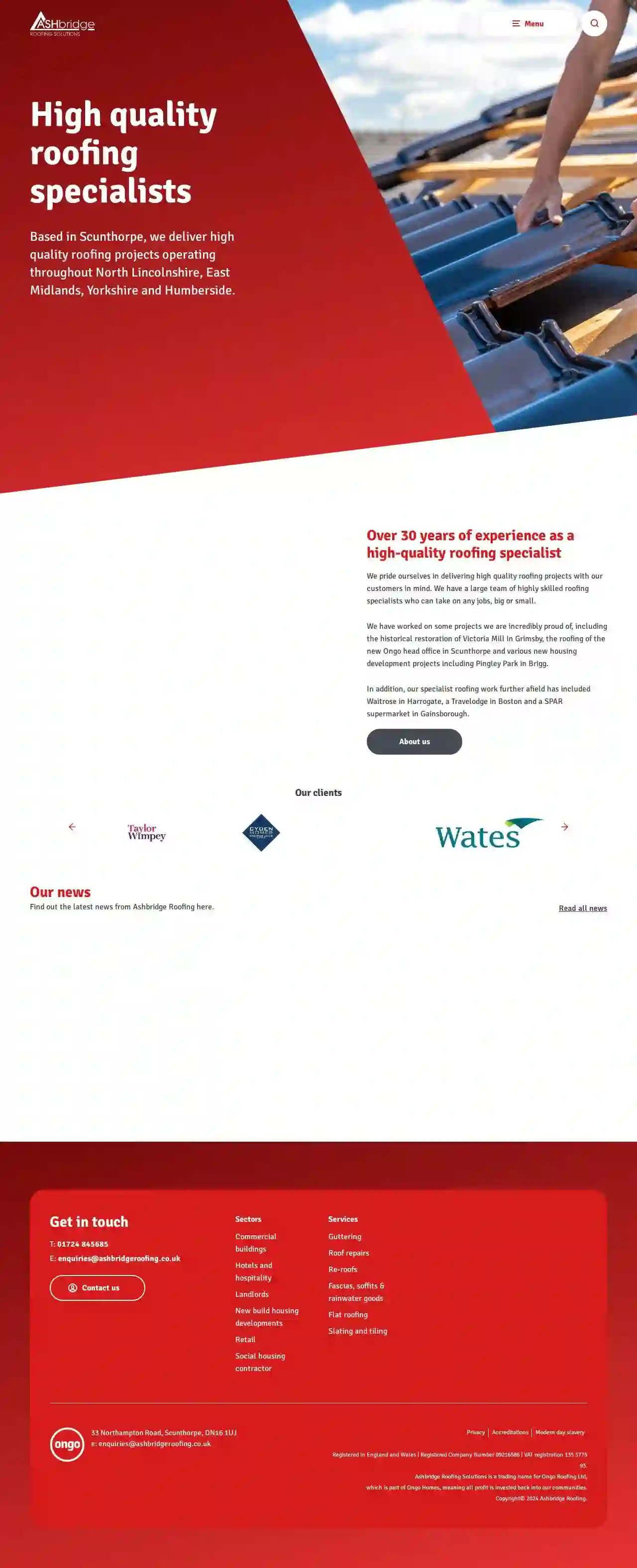Emergency Roof Repair Kingston upon Hull
Top Emergency Roof Repair in Kingston upon Hull
Receive multiple Roof Repair Emergency quotes for your project today! Compare profiles, reviews, accreditations, portfolio, etc... and choose the best service.

Able Roofing Scarborough
4.25 reviews4 Parkfield Gardens, Scarborough, YO12 5NW, GBAble Roofing Scarborough is a local roofing company based in Scarborough, covering all areas of York and the surrounding villages. With over 40 years of combined experience, they offer a prompt, honest, and reliable roofing service. They specialize in all aspects of roofing, including tile and slate repairs, chimney refurbishment, pointing, ridge tiles, valleys, flat roofs, felt and lead, uPVC, fascias, and gutter work. They also carry out GRP fibreglass flat roofing systems and emergency repairs. Able Roofing is insurance company approved and prides itself on providing fantastic customer service.
- Services
- Why Us?
- Our Team
- Testimonials
- Gallery
Get Quote
Little Heath Roofing Limited
52 reviewsGBLittle Heath Roofing is a family-run business with over 40 years of combined experience in providing high-quality roofing services across Southern England. Established by George Wilson and Antony Judson, we pride ourselves on our highly qualified workmanship and excellent customer service. We use only premium roofing products to ensure your roof looks aesthetically pleasing and lasts for many years. Our commitment is to provide the highest standard of service, with efficiency, quality, and fair prices. As roofing specialists based in Hertfordshire and London, we have a wealth of knowledge and are happy to help and advise clients on the best roof coverage and design to suit their needs and ensure maximum lifespan for their roof.
- Services
- Why Us?
- Our Team
- Testimonials
- Gallery
Get Quote
Heritage Roofing & Property Solutions
295 Wellington Street, Grimsby, DN32 7JU, GBHeritage Roofing & Property Solutions is a professional roofing company that has been in business for over 10 years providing unrivalled services. We are a friendly, professional and trustworthy company with a passion for delivering high standards at affordable prices. Focusing on providing high-quality services at fair prices in and around South Yorkshire, Lincolnshire & Humberside, Heritage Roofing & Property Solutions is always on hand to offer the best advice which is backed up by high-quality workmanship. We specialise in all residential and commercial roofing and are proud of being a roofing company you can put your trust into, with excellent reviews and quality service. Please call Heritage Roofing & Property Solutions for further information.
- Services
- Why Us?
- Gallery
Get Quote
R Downie Roofing Contractors
4.115 reviewsScunthorpe, GBR Downie Roofing Contractors are a reliable and sought-after roofing contractors in Scunthorpe. Guaranteed to deliver a professional and reliable service in all aspects of roofing. We take great pride in our work and since being established in 1987 have built a reputation we are proud of, for delivering great results and a professional service. Contact us for all aspects of roofing both domestic and commercial. With a wealth of experience having started working in the roofing business over 30 years ago. We provide roofing services in Scunthorpe and the surrounding areas, this includes guttering, tiling, slating, repairs, and new roofs. To learn more about our services visit our roofing services page. Our services are available to both commercial and domestic customers. We are specialists in private dwelling roof repairs as well as full roof replacements. The reliable and honest service we carry out is why many local businesses choose our roof repair services. Including estate agents who we work closely with to maintain their properties. No job is too big or small All Commercial, Domestic and Emergency work is undertaken You can count on us in an emergency We are available for emergency work 24 hours a day, 7 days a week and 365 days a year. Fully insured We hold full public liability insurance (up to £1,000,000), ensuring our customers peace of mind when using our services.
- Services
- Why Us?
- Our Team
- Testimonials
- Gallery
Get Quote
M.Hatfield construction
GBBuckinghamshire Roofing Network is a network of roofing professionals serving Buckingham and the surrounding areas. Our members offer a wide range of residential and commercial roofing services, including roof repairs, flat roofing, pitched roofing, fascias and soffits, and more. We understand the importance of a well-built roof and are committed to providing our clients with high-quality workmanship and exceptional customer service. Whether you need a small repair or a complete roof replacement, our team of experienced roofers can handle the job.
- Services
- Why Us?
- Gallery
Get Quote
S&D Roofing & Building
44 Holwell Place, Hatfield, AL9 5RE, GBWe are a well-established roofing company that has built up an enviable reputation. Our goal is to meet and exceed the expectations of every customer. We take on all types of jobs from small domestic work to larger commercial projects, all carried out to the highest standards, and at very competitive prices. We are qualified and fully insured with vast knowledge and experience to complete any job. Only quality materials are supplied and used and all our work is guaranteed.
- Services
- Why Us?
- Gallery
Get Quote
Scarborough Roofing Services
GBSouth Yorkshire Roofing Network is a network of roofing professionals serving Eastfield and surrounding areas. We offer a wide range of roofing services for both residential and commercial customers, including roof repairs, flat roofing, guttering, fascias & soffits, and more. Our members are experienced and qualified roofers who are committed to providing high-quality workmanship and customer service. If you need a roofer in Eastfield, contact us today for a free quote. We understand that your roof is one of the most important parts of your home or business. That's why we offer a comprehensive range of services to keep your roof in top condition. From small repairs to complete roof replacements, our members can handle it all. We also offer a variety of roofing materials to choose from, so you can find the perfect solution for your needs and budget. Don't wait until you have a problem with your roof. Contact South Yorkshire Roofing Network today for a free consultation. We'll be happy to answer any questions you have and provide you with a no-obligation quote.
- Services
- Why Us?
- Gallery
Get Quote
Style Roofing
3.829 reviewsGBStyle Roofing is a family-run business with over 25 years of experience in all aspects of roofing. We pride ourselves on providing a high-quality, professional service at competitive prices. Our team of skilled roofers is fully qualified and insured, and we are committed to delivering complete customer satisfaction. We cover all types of roofing work, from small repairs to complete new builds. Whether you need a new roof, a roof repair, or simply your gutters cleaned, Style Roofing is the company to call. We offer a wide range of roofing services, including: Guttering & Roof Clearance UPVC Fascias Flat Roofing New Roofs Roof Repair Chimney Work We are fully committed to providing our customers with the highest quality workmanship and customer service. We are also fully insured, so you can be confident that your property is in safe hands. Contact us today for a free quote.
- Services
- Why Us?
- Our Team
- Testimonials
- Gallery
Get Quote
Fascia Rite Roofing Limited
4.414 reviewsRedbourne Mere, Gainsborough, DN21 4NN, GBWe are an experienced established family roofing company specialising in flat roofing and tiled conservatory roof systems. We serve Lincolnshire, North Lincolnshire and South Yorkshire. All our staff are fully trained and we have more than fifteen years experience offering domestic and commercial customers a wide variety of roofing services including, but not limited to: Flat roofing including flat roof installation and flat roof repairs using different kinds of materials including high-performance felts EPDM firestone rubber and grp fibreglass. Pitched roofing Including pitched roof installation and repairs, single pan tiles, double pan tiles, dry ridge system, slate, concrete and much more. Fascias, guttering and soffits Installation of new fascias, guttering or soffits or repair of your existing fittings. We give a HomePro Insurance backed guarantee on all our work providing the customer with peace of mind in the future. We are happy to offer advice on which type of roof will best meet your requirements and from repairs to new roofs we provide no-obligation quotations. Our comprehensive repair service covers flat roofs, pitched roofs, fascias, guttering and soffits. Whether the problem is caused by storm damage or simply wear and tear, we provide a one-stop solution for all your roofing needs.
- Services
- Why Us?
- Gallery
Get Quote
Ashbridge Roofing
46 reviews33 Northampton Road, Scunthorpe, DN16 1UJ, GBBased in Scunthorpe, we deliver high quality roofing projects operating throughout North Lincolnshire, East Midlands, Yorkshire and Humberside. We pride ourselves in delivering high quality roofing projects with our customers in mind. We have a large team of highly skilled roofing specialists who can take on any jobs, big or small.We have worked on some projects we are incredibly proud of, including the historical restoration of Victoria Mill in Grimsby, the roofing of the new Ongo head office in Scunthorpe and various new housing development projects including Pingley Park in Brigg.In addition, our specialist roofing work further afield has included Waitrose in Harrogate, a Travelodge in Boston and a SPAR supermarket in Gainsborough.
- Services
- Why Us?
- Gallery
Get Quote
Over 12,314+ Roofers onboarded
Our roofing experts operate in Kingston upon Hull & beyond!
Roofyng.co.uk has curated and vetted Top Roofers in Kingston upon Hull. Find a top & reliable pro today.
Emergency Roof Repair FAQs
- Active leaks during a storm: Water pouring into your home.
- Significant roof damage from a fallen tree or debris.
- Missing or severely damaged shingles after high winds.
- A partial or complete roof collapse.
- Ensure Safety: Prioritize safety and do not attempt to access the damaged roof or make any repairs yourself. Wait for professional assistance.
- Contact Your Insurance Company: Report the damage to your insurance company as soon as possible. They will guide you through the claims process.
- Contact a Roofing Contractor: Engage a reputable roofing contractor specializing in fire-damaged roofs to assess the extent of the damage and provide recommendations for repair or replacement.
- Secure the Property: Take necessary measures to secure your property, such as boarding up windows and doors, to prevent further damage or theft.
- Missing or Damaged Shingles: Animals might chew, scratch, or dislodge shingles to create entry points.
- Holes or Gaps: Check for holes or gaps in the roof, soffit, or fascia, indicating animal entry or nesting.
- Droppings or Nesting Materials: Finding animal droppings or nesting materials in your attic or on the roof suggests animal activity.
- Chewed Wires or Insulation: Animals might chew on wiring or insulation, posing a fire hazard.
- Scratching or Gnawing Sounds: Hearing scratching or gnawing sounds coming from your attic, especially at night, indicates possible animal intrusion.
What is considered an emergency roof repair?
What should I do if my roof is damaged in a fire?
How do I deal with a fallen tree on my roof?
What are the signs of roof damage from animals?
What is considered an emergency roof repair?
- Active leaks during a storm: Water pouring into your home.
- Significant roof damage from a fallen tree or debris.
- Missing or severely damaged shingles after high winds.
- A partial or complete roof collapse.
What should I do if my roof is damaged in a fire?
- Ensure Safety: Prioritize safety and do not attempt to access the damaged roof or make any repairs yourself. Wait for professional assistance.
- Contact Your Insurance Company: Report the damage to your insurance company as soon as possible. They will guide you through the claims process.
- Contact a Roofing Contractor: Engage a reputable roofing contractor specializing in fire-damaged roofs to assess the extent of the damage and provide recommendations for repair or replacement.
- Secure the Property: Take necessary measures to secure your property, such as boarding up windows and doors, to prevent further damage or theft.
How do I deal with a fallen tree on my roof?
What are the signs of roof damage from animals?
- Missing or Damaged Shingles: Animals might chew, scratch, or dislodge shingles to create entry points.
- Holes or Gaps: Check for holes or gaps in the roof, soffit, or fascia, indicating animal entry or nesting.
- Droppings or Nesting Materials: Finding animal droppings or nesting materials in your attic or on the roof suggests animal activity.
- Chewed Wires or Insulation: Animals might chew on wiring or insulation, posing a fire hazard.
- Scratching or Gnawing Sounds: Hearing scratching or gnawing sounds coming from your attic, especially at night, indicates possible animal intrusion.